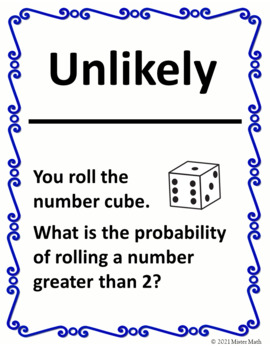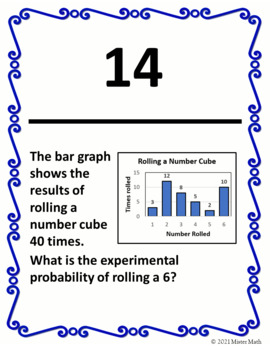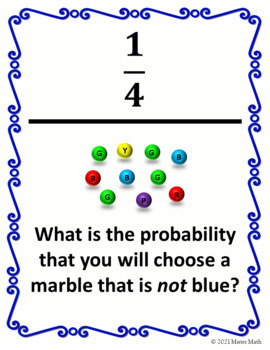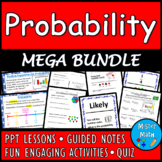Theoretical vs. Experimental Probability Scavenger Hunt
- PDF
- Easel Activity
What educators are saying
Also included in
- This Probability MEGA BUNDLE is just what you've been looking for to assist students in learning about likelihood, simple probability, and experimental/theoretical probability! Included in this bundle, you will find:Outcomes & Events PowerPoint LessonOutcomes & Events Guided Notes (coincidesPrice $15.99Original Price $29.70Save $13.71
Description
Looking for a way to get your students out of their seats and engaged in the content? This scavenger hunt is just what you've been looking for to help students strengthen their skills with theoretical and experimental probability! Perfect for extra practice or a review before an assessment!
The questions included are meant to be posted around the room. Students will then start at a question, working either independently, with a partner, or with a group. Once the question has been answered, students will search the room for the answer, which will be on top of one of the other question sheets. Students will continue to answer questions in this fashion until they are back to the question that they started with, thus completing the circuit. This activity promotes fantastic self-checking skills, since students are required to answer each question accurately to advance through the scavenger hunt.
This scavenger hunt contains 16 questions involving the following topics: outcomes & events, the concept of likelihood, finding the simple probability of events, finding theoretical/experimental probability, and how to use probability to answer questions and make predictions. Plenty of real-life examples are included to give students ample opportunities to practice the skills.
Also included is a Student Worksheet so that students may record their answers during the scavenger hunt and show their work.
☆ CLICK HERE TO CHECK OUT MY OTHER SCAVENGER HUNTS!
********************************************************************************************************
Connect with me!
********************************************************************************************************
You might also be interested in:
Probability PPT & Guided Notes BUNDLE
Outcomes & Events (Probability) PowerPoint Lesson
Outcomes & Events (Probability) Guided Notes
Outcomes & Events (Probability) PowerPoint and Guided Notes BUNDLE
Playing Cards Probability Activity
Number Cube Probability Activity
Theoretical vs. Experimental Probability PowerPoint Lesson
Theoretical vs. Experimental Probability Guided Notes
Theoretical vs. Experimental Probability PPT & Guided Notes BUNDLE
Theoretical vs. Experimental Probability Riddle Activity
Finding Perimeter Scavenger Hunt
Circumference & Perimeter of Composite Figures Scavenger Hunt
Circumference of Circles Riddle Activity
Circumference of Circles & Semicircles Riddle Activity
********************************************************************************************************
Thank you so much for visiting my store! If you want to stay up-to-date on new products and sales, please click on the green ★ next to my name to follow my store!
☆ If you enjoyed this product, please leave a rating and some feedback! ☆
By leaving feedback, you can also earn TpT credits that can be applied to future purchases to save you money!!
********************************************************************************************************
© Copyright 2021 Mister Math, ALL RIGHTS RESERVED. Permission is granted to copy pages specifically designed for student and/or teacher use by the original purchaser or licensee ONLY. You may not share the activities with anyone else unless additional licenses are purchased. Reproducing, copying, editing, distributing, selling, or placing any part of this product on the Internet is strictly prohibited. Doing so is a violation of the Digital Millennium Copyright Act (DMCA).







